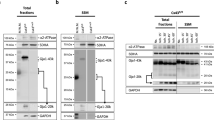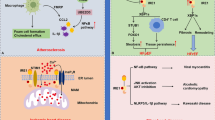Abstract
Heat stress leads to oxidative stress and induces apoptosis in various cells. Endoplasmic reticulum (ER) stress is an important apoptosis pathway. Manganese (Mn) has been shown to enhance the activity of manganese superoxide dismutase (MnSOD). To explore the potential effect of Mn on ER stress and apoptosis induced by heat stress, we examined crucial factors associated with heat stress, ER stress, and apoptosis in cultured primary chick embryonic myocardial cells that had been pretreated with 20 μM Mn for 24 h and then subjected to 4 h of heat stress. The results showed that Mn decreased (P < 0.05) heat stress–induced reactive oxygen species (ROS) production and exerted antiapoptotic effects by increasing MnSOD enzymatic activity. The heat stress–induced accumulation of intracellular calcium was dramatically reduced (P < 0.05). Mn treatment significantly decreased (P < 0.05) the expression levels of the apoptosis-related gene Bax and ER stress markers glucose-regulated protein 78 (GRP78) and CCAAT/enhancer binding protein homologous protein (CHOP) in primary chick embryonic myocardial cells. Additionally, Mn reduced oxidative stress by activating the nuclear factor E2-related factor 2 (NRF2)/SOD2 signaling pathway. Taken together, our findings indicate that Mn attenuates heat stress–induced apoptosis by inhibiting ROS generation, intracellular calcium accumulation, and the ER stress pathway and activating the NRF2/SOD2 signaling pathway to protect myocardial cells from oxidative stress during chick embryonic development.




Similar content being viewed by others
Data Availability
The authors confirm that all data underlying the findings are fully available without restriction. All relevant data are within the paper and its Supporting Information files.
References
Vanmuylder N, Evrard L, Daelemans P, Van RJ, Dourov N (2000) Immunohisto chemical expression of heat shock proteins HSP27, HSP70, HSP90 and HSP110 in salivary gland tumors: a study of 50 cases. Ann Pathol 20(3):190–195
Slimen IB, Najar T, Ghram A et al (2014) Reactive oxygen species, heart stress and oxidative-induced mitoehondrial damage. A review. Int J Hyperthermia 30(30):513–523
]Yang L, Tan GY, Fu YQ, et al (2010) Effects of acute heat stress and subsequent stress removal on function of hepatic mitochondrial respiration, ROS production and lipid peroxidation in broiler chickens. Comp Biochem Physiol C: Toxicol Pharmacol 151(2):204–208
Zeng T, Li JJ, Wang DQ et al (2014) Effects of heat stress on antioxidant defense system, inflammatory injury, and heat shock proteins of Muscovy and Pekin ducks: evidence for differential thermal sensitivities. Cell Stress Chaperones 19(6):895–901
Gu ZT, Li L, Wu F, Zhao P, Yang H et al (2015) Heat stress induced apoptosis is triggered by transcription-independent p53, Ca2+ dyshomeostasis and the subsequent Bax mitochondrial translocation. Sci Rep 5:11497
Gu ZT, Wang H, Li L, Liu YS, Deng XB, Huo SF, Yuan FF, Liu ZF, Tong HS, Su L (2014) Heat stress induces apoptosis through transcription-independent p53-mediated mitochondrial pathways in human umbilical vein endothelial cell. Sci Rep 4(3):4469
Li L, Tan H, Gu Z et al (2014) Heat stress induces apoptosis through a Ca2+-mediated mitochondrial apoptotic pathway in human umbilical vein endothelial cells. Plos One 9(12):e111083
Yu B, Wen LL, Xiao B, Han F, Shi YX (2014) Single prolonged stress induces ATF6 alpha-dependent endoplasmic reticulum stress and the apoptotic process in medial frontal cortex neurons. BMC Neurosci 15:115
Yang Y, Li C, Dai Z et al (2014) Ursolic acid prevents endoplasmic reticulum stress-mediated apoptosis induced by heat stress in mouse cardiac myocytes. J Mol Cell Cardiol 67(67):103–111
Zhang M, Li SW, Pang KY, Zhou ZL (2019) Endoplasmic reticulum stress affected chondrocyte apoptosis in femoral head necrosis induced by glucocorticoid in broilers. Poult Sci 98:1111–1120
Xiong YJ, Yin QR, Jin EH, Chen HT, He SJ (2020) Selenium attenuates chronic heat stress- induced apoptosis via the inhibition of endoplasmic reticulum stress in mouse granulosa cells. Molecules 25:557
Xiong YJ, Yin QR, Li J, He SJ (2020) Oxidative stress and endoplasmic reticulum stress are involved in the protective effect of Alpha lipoic acid against heat damage in chicken testes. Animals 10:384
Qin SZ, Liao XD, Lu L, Zhang LY, Xi L, Guo YL, Luo XG (2017) Manganese enhances the expression of the manganese superoxide dismutase in cultured primary chick embryonic myocardial cells. J Integr Agric 16(9):2038–2046
Li SF, Lu L, Liao XD, Gao TQ, Wang FN, Zhang LY, Xi L, Liu SB, Luo XG (2016) Manganese elevates manganese superoxide dismutase protein level through protein kinase C and proteintyrosine kinase. Biometals 29(2):265–274
Zhu YW, Lu L, Liao XD, Li WY, Zhang LY, Ji C, Xi L, Liu HS, Odle J, Luo XG (2017) Maternal dietary manganese protects chick embryos against maternal heat stress via epigenetic-activated antioxidant and antiapoptotic abilitie. Oncotarget 8(52):89665
Liao XD, Zhu YW, Lu L (2019) Maternal manganese activates anti-apoptotic-related gene expressions via miR-1551 and miR-34c in embryonic hearts from maternal heat stress(Gallus gallus). J Therm Biol 8:190–199
Tombal B, Denmeade SR, Isaacs JT (1999) Assessment and validation of a microinjection method For kinetic analysis of [Ca2+] in individual cells undergoing apoptosis. Cell Calcium 25:19–28
Lynch K, Fernandez G, Pappalardo A, Peluso JJ (2000) Basic fibroblast growth factor inhibits apoptosis of spontaneously immortalized granulosa cells by regulating intracellular free calcium Levels through a protein kinase Cdelta-dependent pathway. Endocrinology 141:4209–4217
Niture SK, Kaspar JW, Shen J et al (2010) Nrf2 signa-ling and cell survival. Toxicol Appl Pharmacol 244(1):37
Ji Q, Gao JB, Zheng Y et al (2017) Inhibition of microRNA-153 protects neurons against ischemia/reperfusion injury in an oxygen-glucose deprivation and reoxygenation cellular model by regulating Nrf2/HO-1 signaling. J Biochem Mol Toxicol 31(7):e21905
Gu XH, Hao Y, Wang XL (2012) Overexpression of hest shock protein 70 and its relationship to intestine under acute heat stress in broilers:2.intesinal oxidative stress. Poultry Science 91(4):790–799
Khan I, Lee KL, Xu LG, Mesalam A, Chowdhury MMR, Joo MD et al (2017) Improvement of in vitro-produced bovine embryo treated with coagulansin-a under heat-stressed condition. Reproduction 153(4):421–431
Matsuki S et al (2003) Suppression of cytochrome c release and apoptosis in testeswith heat stress by minocycline. BBRC 312:843–849
Roberts GT et al (2008) Microvascular injury, thrombosis, inflammation, and apoptosis in the pathogenesis of heatstroke a study in baboon model. Arterioscl Throm Vas 28:1130–1136
Oberley LW, Buettner GR (1979) Role of superoxide dismutase in cancer: a review. Can Res 39(4):1141–1149
Bhandary B, Marahatta A, Kim HR, Chae HJ (2012) An involvement of oxidative stress in endoplasmic reticulum stress and its associated diseases. Int J Mol Sci 14:434–456
McAnulty SR, McAnulty L, Pascoe DD, Gropper SS, Keith RE et al (2005) Hyperthermia increases exercise-induced oxidative stress. Int J Sports Med 26:188–192
Burdon RH, Gill VM, Rice-Evans C (1987) Oxidative stress and heat shock protein induction in humancells. Free Radic Res Commun 3:129–139
Skibba JL, Powers RH, Stadnicka A, Cullinane DW, Almagro UA et al (1991) Oxidative stress as a precursor to the irreversible hepatocellular injury caused by hyperthermia. Int J Hyperthermia 7:749–761
Zhu YW, Lu L, Li WX et al (2015) Effect of dietary manganese on antioxidant status and expression levels of heat-shock proteins and factors in tissues of laying broiler breeders under normal and high environmental temperatures. Br J Nutr 114(12):1–10
Kupsco A, Schlenk D (2015) Oxidative stres, unfolded proteinresponse, and apoptosis in developmental toxicity. Int Rev Cell Mol Biol 317:1–66
Berridge MJ, Lipp P, Bootman MD (2000) The versatility and universality of calcium signalling. Nat Rev Mol Cell Biol 1:11–21
Breitwieser GE (2006) Calcium sensing receptors and calcium oscillations: calcium as a first messenger. Curr Top Dev Biol 73:85–114
Hajnoczky G, Davies E, Madesh M (2003) Calcium signaling and apoptosis. Biochem Biophys Res Commun 304:445–454
Dubois C, Vanden AF, Sehgal P et al (2013) Differential effects of thapsigargin analogues on apoptosis of prostate cancer cells:complex regulation by intracellular calcium. FEBS J 280(21):5430–5440
Kundu JK, Surh YJ (2010) Nrf2-Keapl signaling as a potential target for chemoprevention of inflammation-associated carcinogenesis. Pharm Res 27(10):999–1013
Calvert JW, Jha S, Gundewar S et al (2009) Hydrogen sulfide mediates cardioprotection through Nrf2 signaling. Circ Res 105(4):365–374
Bae SH, Sung SH, Oh SY et al (2013) Sestrins activate Nrf2 by promoting p62-dependent autophagic degradation of Keap1 and prevent oxidative liver damage. Cell Metab 17(1):73–84
Funding
This research was funded by National Natural Science Foundation of China (No. 03119023); Youth Science and Technology Fund Scheme in Gansu (No. 20JR5RA013); Special Funds for Talents of Gansu Agricultural University (No. 2017RCZX-18).
Author information
Authors and Affiliations
Contributions
Conceptualization, Shizhen Qin; investigation, Rui Wang; writing – original draft, Rui Wang and Shijiao Qin; writing – review and editing, Yanli Guo; supervision, Defu Tang; project administration, Zhaoguo Shi; funding acquisition, Shizhen Qin.
Corresponding author
Ethics declarations
Conflict of Interest
The authors declare no competing interests.
Additional information
Publisher's Note
Springer Nature remains neutral with regard to jurisdictional claims in published maps and institutional affiliations.
Rights and permissions
About this article
Cite this article
Qin, S., Wang, R., Tang, D. et al. Manganese Mitigates Heat Stress–Induced Apoptosis by Alleviating Endoplasmic Reticulum Stress and Activating the NRF2/SOD2 Pathway in Primary Chick Embryonic Myocardial Cells. Biol Trace Elem Res 200, 2312–2320 (2022). https://doi.org/10.1007/s12011-021-02810-2
Received:
Accepted:
Published:
Issue Date:
DOI: https://doi.org/10.1007/s12011-021-02810-2




